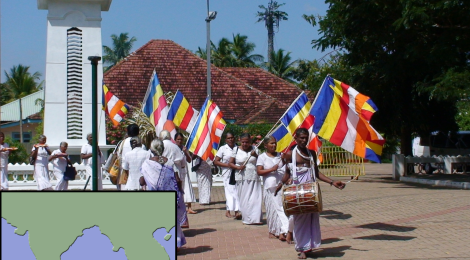
Sinhala people
The Sinhala are the people that inhabit the island of Sri Lanka (previously known as Ceylon during colonial times). They speak an Indo-Aryan language, a relative of the languages spoken in Northern India, especially close to Bengali, and unlike the Dravidian languages spoken in Southern India and the northern tip of Sri Lanka (Tamil). They use their own Sinhalese alphabet, a beautiful curlicued descendant of the Brahmic alphabet.
Their origins are shrouded in mystery and legend. According to Sinhalese chronicles, Indo-Aryan settlers from North-east India reached Sri Lanka led by the Prince Vijaya, around 6th century BC. They built the great city of Anuradhapura and intermingled with the original population. The name Sinhala comes from Sanskrit simha, which means ‘lion’, and it is related to the lineage of Vijaya.
Another famous capital of the Sinhala was Sigiriya, a city and monastery built on top of an enormous boulder in the middle of the jungle.
During the reign of the Indian emperor Ashoka, his son arrived at the island and the Sinhala became Buddhist, an event that would alter their history significantly. Ashoka’s daughter carried a sapling of the Bodhi tree, under which Buddha achieved enlightment in Northern India, to Sri Lanka, and it was planted where it still stands today. Buddhism soon lost influence in the Indian subcontinent, but the Sinhala kept being strong adherents to Buddha’s teachings. In fact, this people has been instrumental in spreading Buddhism and Indic culture to South-East Asia, where it has remained till our days.
In recent times, the Sinhala have been fighting against the Tamil secessionists in North Sri Lanka, a people that is more linked with the Tamil populations in Southern India. The war is over now, and it seems that both Sinhala and Tamil are learning to cohabit the island, with both languages being official all round Sri Lanka.

Recent Comments